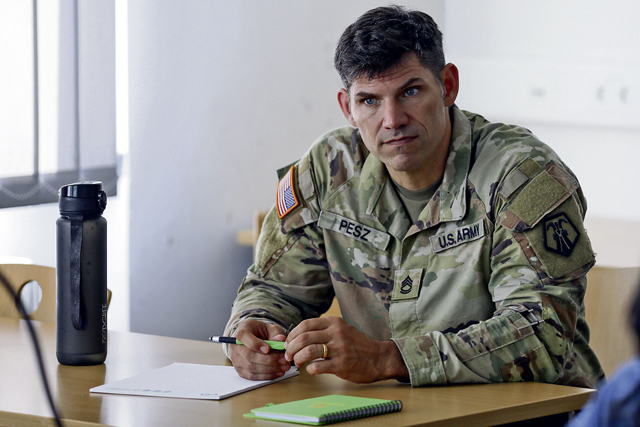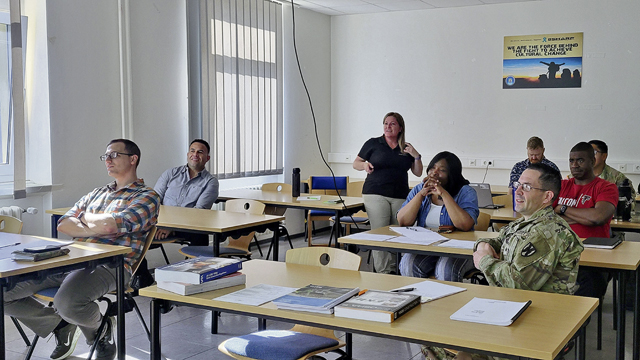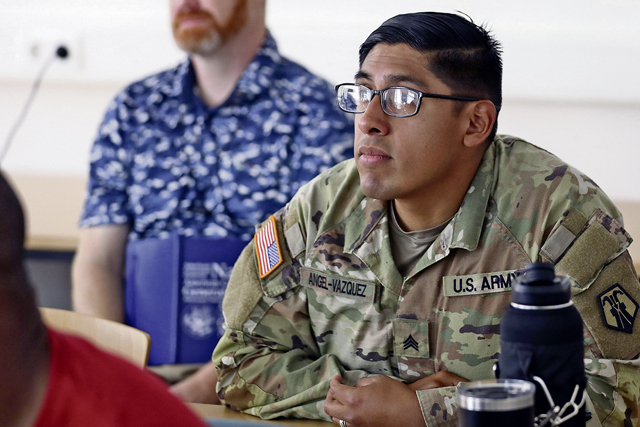
The room was dark and nearly a dozen 21st Theater Sustainment Command personnel leaned forward with wide eyes in a room lit by the dull glow of a PowerPoint slide. Picture after picture was a grim reminder of how dangerous a construction zone can be.
“Who has a story from a past workplace where they identified a hazard? Did you know what to do to mitigate the hazard,” asked Stefanie Diaz, the 7th Mission Support Command safety director and instructor for the ten-hour Occupational Safety and Health Administration construction safety course.
The 21st TSC personnel that comprised the class were from an assortment of career areas that ranged from medical, logistics, and military police. The students spent two days learning how to keep their colleagues safer during the command-sponsored course.
The course ties into several key priorities of the 21st TSC. “Safety is important in everything we do. Mission readiness is hard to maintain if a workplace is needlessly unsafe,” said Diaz. “The unit has a ‘People First’ focus. That includes keeping those people safe so they can do their jobs effectively and go home to their families safe and secure.”

The OSHA-based curriculum focuses on identifying hazards in construction-related work areas, as well as materials handling, storage, use and disposal.
“There are inherent dangers in all construction worksites. Recognizing these hazards and how to mitigate them is one of the most important things I can teach to set our people up for success,” said Diaz.
The PowerPoint-driven course was peppered with spirited discussions regarding equipment safety and employer and supervisor responsibilities in the realm of safety.
After the first day, students were tasked with an interactive exercise. “I wanted everyone to be more aware of the surroundings where they work and live,” said Diaz. “Everyone owed homework that identified and described a material hazard from their work or home. I asked each person to look up their item in the material safety data sheet to find information such as the properties of each chemical, the physical health, and environmental health hazards and what protective measures and safety precautions are needed for handling,” Diaz explained.

U.S. Army 1st Lt. Michael Bordas, the 16th Sustainment Brigade’s Special Troops Battalion collateral duty safety officer, who has a background in safety from his prior civilian career, attended the class to get a refresher on several topics.
“This is something I have a passion for,” said Bordas. “This course was especially interesting because of the construction angle. I learned a lot about safety measures in commercial digging, like sloping, shielding and shoring. I’ve never really thought too much about those sorts of things before this class. I even drew diagrams in my notes to better understand the differences and benefits between the safety methods,” he said.
Bordas, who recently won the U.S. Army Europe and Africa’s Individual Excellence Award for Safety plans to go back to his unit with a list of five lessons learned that he has noticed that his unit should not do.
“Being able to go back with this new knowledge and educate the unit is important. We have a company that uses forklifts all the time. I am now empowered with new safety information to help them operate safer,” Bordas said.
According to Diaz, the 21st TSC funded the course. The cost for the training is averaged out to $10 per person. Even if each student only implements one best practice from what they have learned here, it could potentially save lives and the Army millions of dollars in the future, she said Diaz.
“Our top priority continues to be the safety of our people. By investing in comprehensive OSHA training, we not only comply with regulatory requirements, but more importantly, we empower our Soldiers and civilians with the knowledge and skills necessary to create a safer working environment,” said John Rice, the 21st TSC safety director.
For more information about future safety training and education programs, contact the 21st TSC safety office at: reinhard.h.wolsiffer.ln@army.mil, 523-0551.


